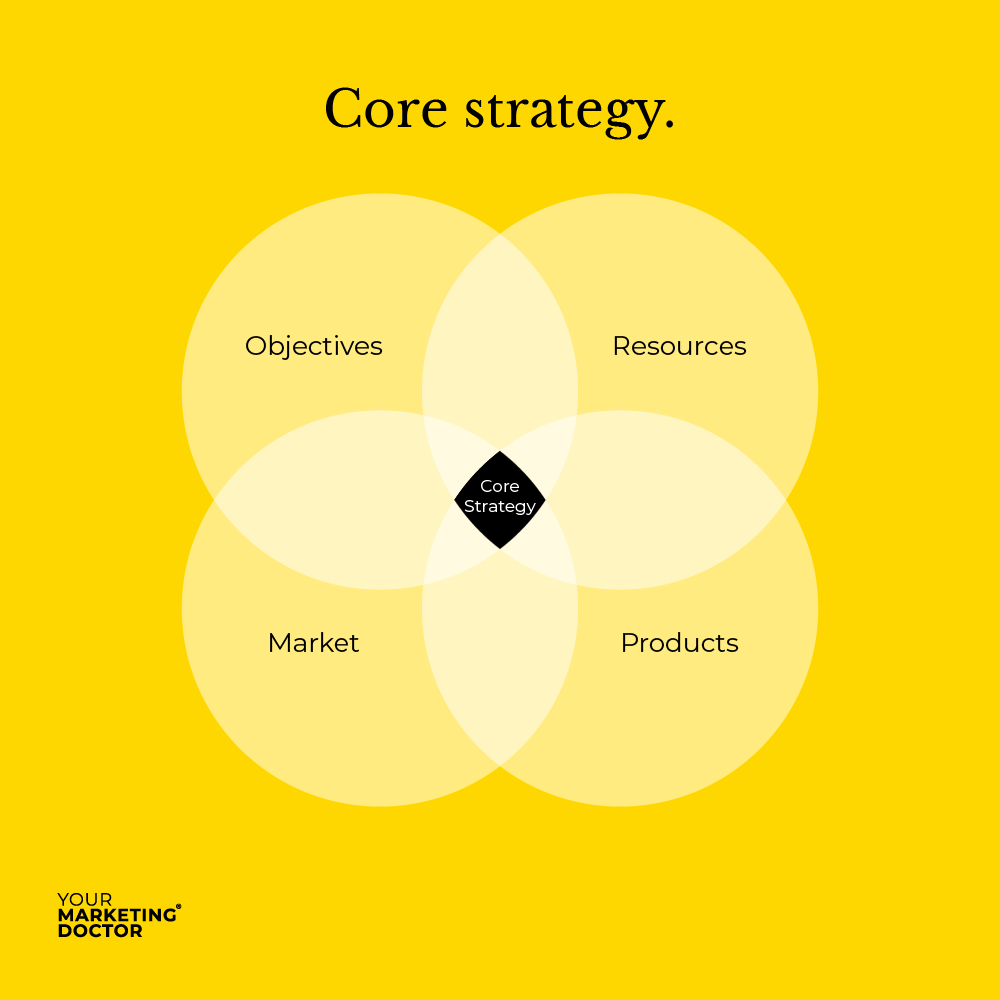Core strategy is the glue that holds your marketing together. It is a statement of your business’ objectives and how you plan to achieve them. However, it is not an easy thing to write or develop, as it must be based on a lot of thinking and analysis.
Let’s simplify the concept down.
Your Core Strategy is literally the pillar of your business. It gives you focused direction and helps you make informed decisions for the future.
The four key elements of Core Strategy can be broken down like this:
Objectives
Your “top-level” business objectives and your marketing objectives, ie. where you want your business to be over a period of time, and what you need to do to get there.
Product(s) or service(s)
The things you sell. Each product, or product group, should have its own very specific proposition.
Market(s)
What market are you operating in? The market is not just all about your customers, it also describes your competitors and where you sit among them, also known as “positioning.”
Resources
These are the resources you need to deliver your strategies. For many businesses, resources are scarce. So, it is really important to understand what you have at your disposal internally versus what resources you need to seek out.
The four elements of Core Strategy should not be taken lightly. For each, there must be some deep diving into your business, your customers, your competitors, and your resources and competences.

This is where a full Strategic Marketing Audit should be undertaken. A strategic marketing audit is not about your marketing activity. It is a deep dive into all the finer details of business – it is a snapshot of everything that affects your business, both internally and externally.
Think of Core Strategy as a jigsaw puzzle. There are a lot of pieces to the puzzle – and it can be overwhelming. Imagine you are tipping thousands of jigsaw pieces onto a table. You are not sure what the picture is – or indeed whether you have more than one picture among the pieces! You must start somewhere, but the secret is to simplify it down, one area at a time.
An example scenario based on a recent conversation
I recently delivered a Free Marketing Health Check to a company that’s developed a digital product. The company has also been delivering services as its core offering for many years.
The problems:
- No direction or idea on where to take the business next
- So many ideas, nothing yet concrete
- Unable to make any informed decisions
From the one-hour call, I heard about their frustrations and worries. It’s safe to say that the owner was in a bit of a rut about where to take the company next.
My diagnosis:
- No core strategy
The digital product, a subscription-based model, was immediately jumping out at me. And the owner was unable to see the wood for the trees. They are so bogged down in the day-to-day delivery of services.
My recommendation was to work towards developing a Core Strategy that would arrange all the pieces of the business into digestible chunks. The owner should first think of each product separately and work on the proposition of each in turn.
The first step would be to define and analyse the market for each product. This would involve some customer segmentation – where we define each customer group and arrange by profitability.
Then, we think about positioning. This is where the product offering sits against competitors. Remember, it could be that there are certain markets that are saturated, against others that have little competition. So, it’s vital to draw a detailed picture of where your offering can sit.
I would suspect that new customer groups and markets would emerge as we go. In this case, it is a good idea to think about developing the product to meet the needs of a particular market, if it would be profitable to do so.
Alongside this, setting objectives is the key part of Core Strategy. This should start with the top-level business (financial) objectives, both long and short-term. Then we can develop the marketing objectives to help you achieve it.
So, in the case of this example business, income from subscriptions may depend heavily on customer retention. The longer a customer subscribes, the lifetime value is greater. The ultimate goal would be to gain large number of subscribers retained over a long period. So the first marketing objective could be to “achieve an average customer value of X from subscriptions over 12 months.”
Then that’s where your tactical strategies come in. In order to achieve our subscription objective, we need to work on customer retention. This involves investment in improving customer experience, and customer satisfaction. We can also incentivise customer advocacy… and the strategy develops.
You should always expect your products and customer base to evolve as you develop the strategy. The idea is to create a clear picture (or even numerous pictures) from those jigsaw pieces – a picture that will show you what you need to do next with your business.

